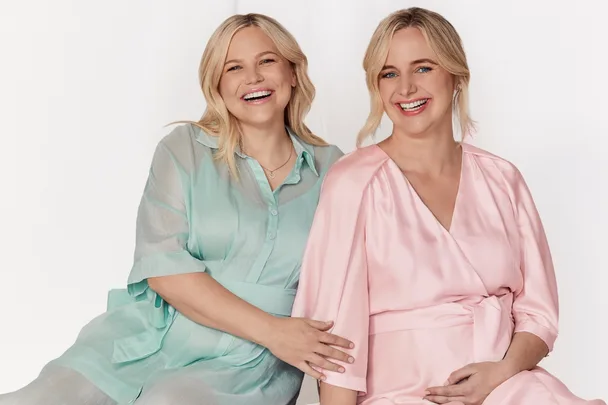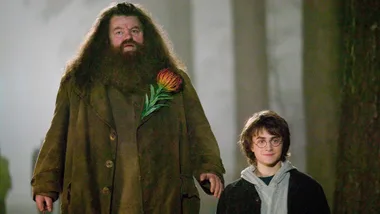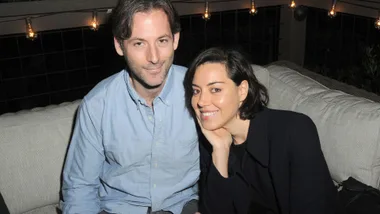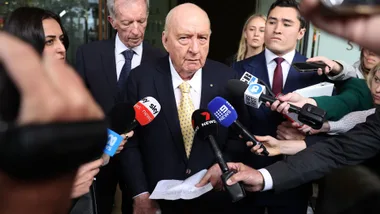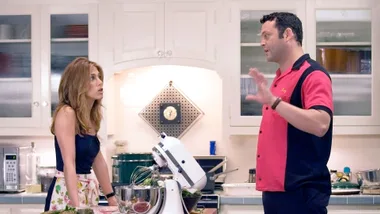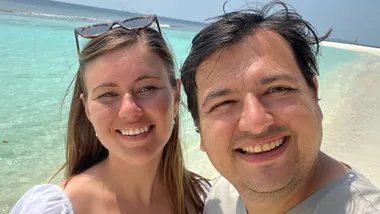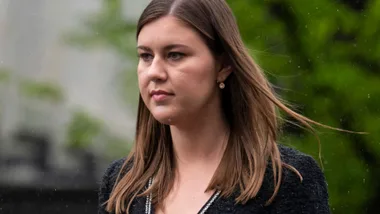Suzie and Laura Francis-Mathers’ baby announcement on Instagram not only marked the delightful next step in the couple’s infectious love affair, it also represented an emotional triumph after a harrowing two-year IVF battle.
Standing side by side with wide smiles and cute noticeboards, they revealed that Suzie was due with “Baby One” in July and Laura would give birth to “Baby Two” three-and-a-half weeks later, in August.
And as if it couldn’t be more perfect, there was also a sweet postscript: they were expecting a girl and a boy. To anyone who knows talented musical theatre star Suzie and her equally engaging TV-producer wife, it was the extraordinary culmination of a romance that began in London, led to a glamorous chateau wedding in France and then a return home to start their family in Sydney. To those who don’t know them, these women with their open affection were a vision of hope for same-sex couples and an emblem of the evolution of the modern Australian family.
Yet, as they reveal for the first time the struggle behind their quest to become parents, it becomes clear that this isn’t simply the latest good fortune in their remarkably serendipitous lives, but the hard-won result of years of heartbreak and trauma. “This isn’t just a story about two girls who went, ‘Oh my God, it would be so much fun if we had babies together,’” says Suzie, as the pair sit, hands entwined, at their home in Sydney’s inner west.
Rather, what transpires is a tale of appalling medical errors, the complexities and vagaries of the IVF process, tough decisions, huge costs, shock, anger, exhaustion and, ultimately, a mutual and deeply tested resilience and love that will underpin their parenting.
Upstairs, two bassinets sit together, tiny baby clothes hang in the wardrobe and a pile of children’s books – purchased by Laura’s mum and featuring rainbow families – await the almost-twins. “It’s very much anyone’s game. We’re getting our heads around the logistics of that and we probably need to have an additional support person on the go,” Laura says, noting with amusement the uniqueness of getting to watch your spouse give birth while eight months pregnant yourself. “As Suzie said, if this were some kind of rom-com, she’d be giving birth and my waters would break.”
While their journey to parenthood is compelling, it is also the novelty of their situation that invites curiosity. The couple, who will both turn 38 shortly before their due dates, are getting used to fielding questions, some very personal. As Laura says, “Some of the questions seem ridiculous to us but it comes from being intrigued and inquisitive and 99 per cent of the time there’s no malice. The fact people are asking them means our kids might get asked them, so it’s great to be able to navigate that.”
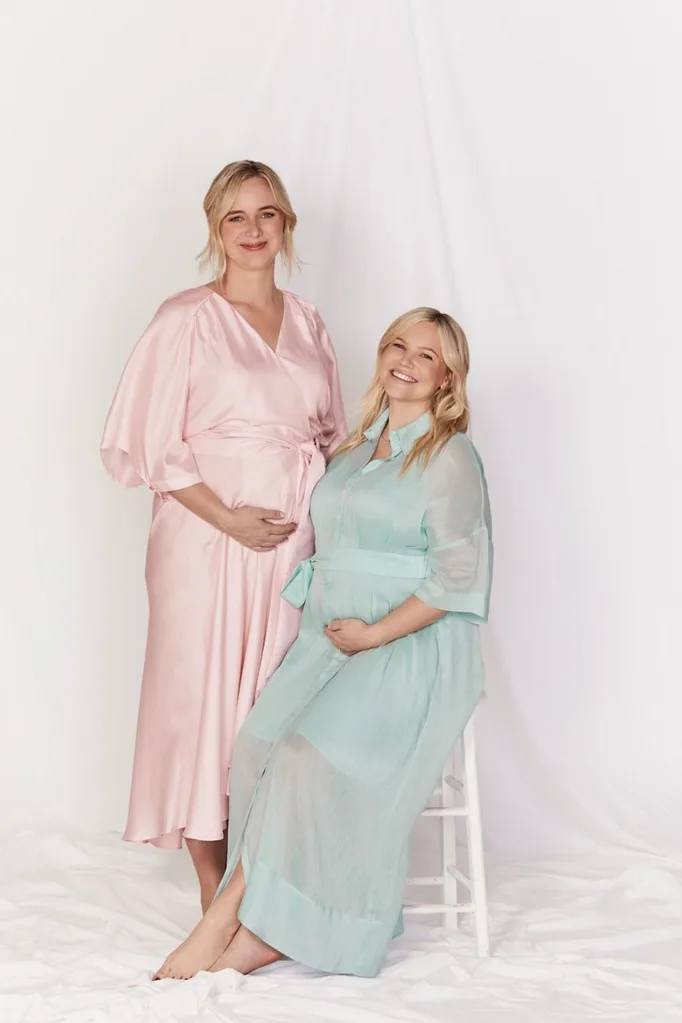
So, in order of the most frequently asked, yes, the babies have been conceived with the same donor sperm. They considered asking a friend but in the end used an overseas donor, largely because there was more information available, including extensive family histories along with recordings of their voices.
With no waiting lists, as there often are in Australia, they could expedite the process. As for physical attributes, they were secondary to character. Suzie, who has starred in Mamma Mia! The Musical and toured internationally in Wicked, says, “We were definitely looking for kindness and for the reason why they were doing it.” Laura adds, “Our children will have the right to contact the donor when they’re adults, so we chose someone we felt we could sit around a table with [while] drinking a glass of wine in 18 years’ time.”
Another question they get asked is whether they will love each other’s babies as much as their own. They both laugh at the suggestion, and during our interview they only ever refer to their offspring as “Baby One” and “Baby Two”, never “Suzie’s baby” or “Laura’s baby”. As Suzie says, “We’re creating a family. We’re bringing two babies into one household and we’re both raising them and we’re going to raise them equally.”
Indeed, they’re hoping each of them can breastfeed both babies, not just to help with the bonding process but for convenience. “We feel we’ve got an absolute bonus as two women because we have two sets of boobs,” Laura points out.
It’s a measure of how far Australian sentiment has progressed around same-sex relationships that they have not received any negative feedback, and both are grateful for the work done by those before them.
As they sip kombucha and laugh about their differing experiences of pregnancy (Suzie endured morning sickness while Laura is now suffering more aches and pains) they want to share not just their happy news, but the wrenching despair in their journey to become parents.
The numbers are eyepopping: two years, six rounds of IVF egg retrieval between them, 10 transfers, two chemical pregnancies and more injections than either care to count. And, it should be noted, they are a couple who approached IVF not as a last resort but as the first step in the road to parenting. “We were bright-eyed and bushy-tailed,” Suzie recalls. “Unlike a lot of couples, we were coming in fresh.”
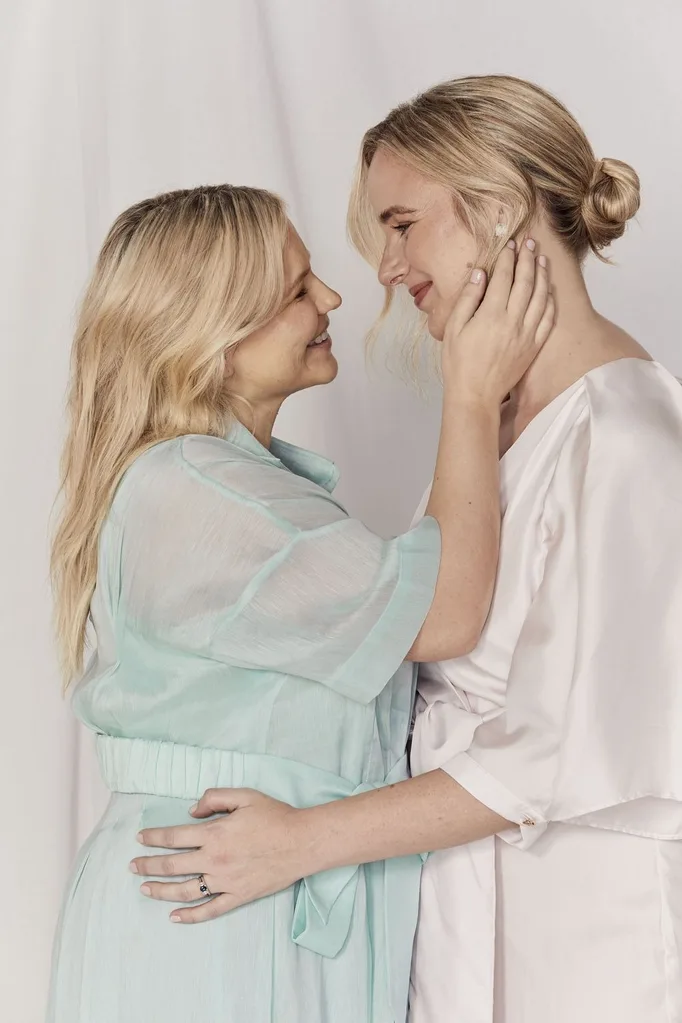
With both wanting to carry a child, they decided that due to Suzie’s work commitments Laura would try for a baby first. Blood tests in May 2019 revealed they were both fertile so they proceeded to choose their donor and prepare for IVF. Even when the outbreak of the pandemic closed IVF clinics early in 2020, they were only delayed a month and, fortuitously, the day after clinics reopened, Laura started her period, meaning the hormone injections and subsequent egg-retrieval process could begin.
Groggy after the procedure, she remembers a nurse leaning over to say they’d harvested 50 eggs. “She told me it was the most they’d ever seen at this hospital. We were planning the choir.”
Like everything with IVF, there’s constant waiting. Five days later they were told they had 13 viable embryos. Not a choir exactly, but for a couple with equivalent qualifications in musical theatre, it was a good-sized vocal ensemble.
Next they were offered pre-implantation testing to detect any chromosomal abnormalities in the embryos. They opted for a new and less-invasive test called NI-PGT offered by Monash IVF. But when the results came back they were shocked. Of the 13 embryos, only two were normal, one was inconclusive and 10 were deemed abnormal. Laura was confused. “I looked up the charts of what is normal for each age group and it didn’t appear anywhere near the realms of normal for my age,” she says. “We were told this is just what happens. Later it was suggested that because I’d had so many eggs the quality might have been compromised.”
While they’re both inquiring types—and Laura’s current job as a supervising producer on ABC-TV’s 7.30 program requires her to be relentless in the pursuit of facts—this would be the first of many occasions when they would defer to the experts. In any case, as natural optimists they focused on the positive.
Perhaps this test had saved them time implanting embryos that were never going to take. They moved forward, implanting the viable embryos over successive months. In October 2020, after two failed attempts, Laura returned a positive pregnancy test. They were elated. But four days later a second test came back negative. As they would come to learn, these misfires of sorts are known in the industry as chemical pregnancies.

By now, 17 months had passed and Suzie was 36. It seemed wise to harvest, fertilise and freeze her eggs. “The longer it took for me to get pregnant, the stakes were getting higher and higher,” Laura says. “I started to think I was holding Suzie up. You wouldn’t be human if you weren’t thinking, ‘So when is it going to be my turn?’ ”
What followed was a gut-wrenching trail of disappointments. Suzie’s first round of IVF produced no embryos. “I was devastated,” she says. “We got very drunk that night.”
Four months later, having undergone a second round of IVF, Laura had another transfer. Two weeks later, a blood test showed she was pregnant. What’s more, her hormone levels were high. Holidaying in Perth with Suzie’s family, they presented her mum, who was turning 60, with a tiny onesie. On the front it cheekily read: “Whose grandma is turning 60?”
But the elation soon gave way to heartbreak. Further blood tests showed the pregnancy was failing. Recalling that time, Laura says, “It’s shared
disappointment. Suzie’s bawling her eyes out just as much as I am when there’s a negative result. It’s not ‘this is what’s happened to you’ or ‘what’s happened to me’. It’s ‘what’s happened to us’.”
Over the following months there was good news and bad. Suzie’s second round of IVF produced two embryos for the freezer. Meanwhile, a laparoscopy revealed Laura had stage three endometriosis. After surgery for that, she underwent two more rounds of IVF and produced two more embryos, yet both transfers – along with an intrauterine insemination, where the donor sperm is injected at the natural time of ovulation – failed. With Laura physically and emotionally broken, they decided it was time for Suzie to try to fall pregnant.
“All of a sudden it was up to me to try to make this happen,” says Suzie. “I didn’t want to take this away from Laura but I know she didn’t want to keep me waiting.”
Indeed, it’s testament to their communication that they’ve come through what both agree is the hardest thing they’ve faced. “I can see how IVF breaks couples,” says Laura, “but I’m so proud of how we navigated it.”
You couldn’t make up what happened to them next. Months earlier, the couple had been told that the type of genetic testing done on Laura’s first round of embryos had been suspended because investigations revealed a higher number of embryos were being classified abnormal than in clinical trials.
While other patients had destroyed their “abnormal” embryos, a complication in the couple’s paperwork meant theirs were still in storage. There was an option to re-test.
Just hours before Suzie began the process for her embryo to be implanted, Laura received a call saying that eight of her original 10 embryos were not “abnormal” but perfectly viable and available for transfer.
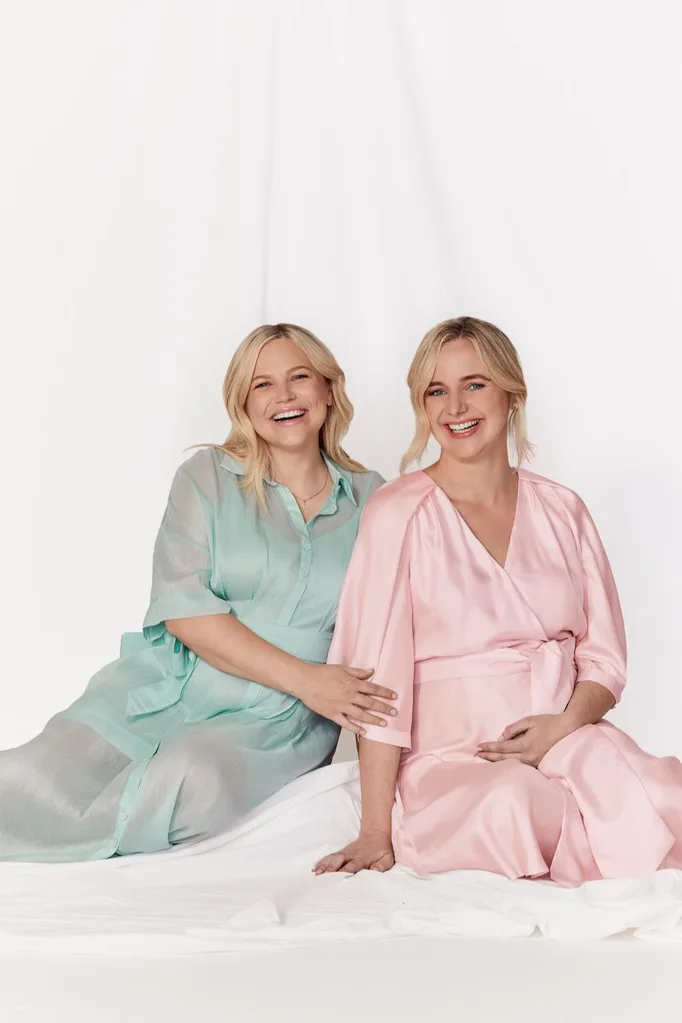
Tears pool in her eyes as she recalls the assault of emotions. “I’m generally not an angry person but I’d lost two years, and after all these injections and all these hormones to learn that I had eight embryos … how the hell had this happened?”
They had 24 hours to make a decision. Five months on from the endometriosis surgery, Laura was told she was in the “magic window” for implantation. Should they try for a baby at the same time? There were benefits, including sharing maternity leave and having their children start school together.
Even better, they’d be done with IVF. Miraculously – and they do regard it as a miracle – both fell pregnant. Laura’s sobs, captured on their video on Instagram, are achingly raw and convey the heartbreak behind the happiness.
“It was two years of sobbing that just came out,” she says. “It was so many mixed emotions – relief after two years of putting my body through so much, the emotional journey we’d been on, the hope and the expectation.”
With so much out of their control, they wanted to know the sex of the babies, even though they were happy with any combination. The couple are thrilled to be expecting a boy and a girl, with Laura carrying their son and Suzie carrying their daughter. Suzie and Laura are now part of a class action against the IVF clinic. The clinic has covered some additional costs due to the errors, but the process still cost them tens of thousands of dollars. And how do you count the physical and emotional toll? As they say, it’s an injustice that should never have happened.
For now, though, they are celebrating this latest twist in their surprisingly synchronised lives. Having been introduced in 2015, where they regaled each other with their dating exploits with boys – though Suzie had previously had same-sex relationships – their friendship quickly grew into love. Laura initiated their first kiss, while Suzie was the first to propose marriage in 2017. Their relationship is as traditional as it is modern, with Suzie seeking permission from Laura’s parents to marry their daughter before going down on bended knee with a ring.
Their picturesque 2019 wedding at Chateau de Lisse, in south-west France, featured both brides in exquisite white dresses – coincidentally by the same designer. Even now, with pregnancy cravings, Laura insists that even though she, too, is pregnant she happily made a recent late-night dash to the shops. “I didn’t want you to have the feeling,” she says, smiling at Suzie, “that there was no-one to get ice-cream.”
With their only saving coming through two-for-one Calmbirth classes, Suzie says they have a great deal of empathy for others going through IVF.
“To be able to share our story with other people and to know we made it through this, and this is the result, is really fulfilling for us,” she says.
As their family life begins, Laura’s pain is still close to the surface. “Being able to survive that, we can survive anything.” She pauses for a moment before solemnly whispering, “We will never forget that experience – it still lies within us. That trauma doesn’t just suddenly disappear. But to have this joy as well is just more than we could have wished for.”
The story originally appeared in the July issue of maire claire Australia.
